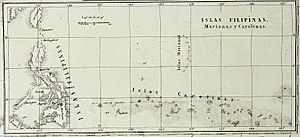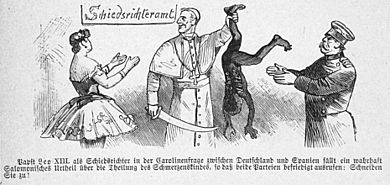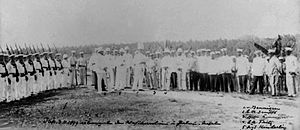Carolines Question facts for kids
The Carolines Question was a big disagreement between Germany and Spain in 1885. They were arguing over who owned the Caroline Islands and Palau in the Pacific Ocean. This happened when Germany was just starting its colonial empire and Spain's own Spanish Empire was nearing its end.
Contents
Who Owned the Islands?
Spain had believed the Caroline Islands were theirs since the Age of Discovery, a time when European countries explored many new lands. A very old agreement, the Treaty of Zaragoza, had even said these islands were in Spain's area of influence.
However, Spain did not really control the islands much. In 1875, Spain agreed with Germany not to charge special taxes on goods coming into the islands. This helped German businesses trade freely in the Pacific.
Germany was also expanding its power. In 1884, an agreement between Britain and Germany said that Kaiser-Wilhelmsland (part of modern-day Papua New Guinea) and the islands north of it were Germany's. Soon after, Germany raised its flag on Mioko Island. These actions brought Germany closer to Spain's interests.
By early 1885, a German trading company asked its government to take over the Caroline Islands. They wanted to protect their trading business there. German leaders, including Chancellor Otto von Bismarck, thought Spain was about to claim the islands officially. In July 1885, Kaiser Wilhelm I approved Germany taking control of the Carolines.
Raising the German Flag
Chancellor Bismarck told the German navy to raise the German flag over the Carolines. On July 31, 1885, Lieutenant Commander Paul Hofmeier was ordered to sail his gunboat, the Iltis, to Yap and Palau. His mission was to raise the German flag and make agreements with local chiefs to show Germany was in charge.
On August 4, 1885, Germany told the Spanish government they were taking the Carolines under their protection. Spain's Foreign Minister, José de Elduayen y Gorriti, immediately said Germany had no right to do this. Spain sent a message to Germany, saying the Carolines had belonged to Spain since 1543.
However, Spain also promised that German traders could still trade freely in the Carolines. In Spain, newspapers started writing angry stories, and people held anti-German protests. More than 30,000 people protested in Madrid, and there were demonstrations in about 80 other places across the country.
The Carolines Question made Spain's King Alfonso XII look bad to his political opponents. Because of this, his government wanted the problem solved quickly. Bismarck was surprised by how many people protested. On August 23, 1885, he said Germany did not want to ignore Spain's historical rights. He suggested that an independent person should decide who was right. But Spain did not show clear proof of its ownership.
On the evening of August 2, 1885, the German gunboat Iltis arrived at the harbor in Yap. It found two Spanish warships already there: the San Quentin and the Manila. These ships had brought a future Spanish governor, priests, and soldiers to the island. Spain had already started building a government post. Even so, Hofmeier raised the German flag. The Spanish then raised their own flag. It looked like a fight might happen, but the Spanish ships left the island.
Trade Worries
When news of the German flag-raising reached Madrid in early September 1885, angry crowds gathered around the German embassy. The German consulate in Valencia was also attacked. The Spanish government worried the situation could get out of control and urged Germany to find a solution quickly. Meanwhile, another German gunboat, the Albatross, continued to raise the German flag on many Caroline Islands between September 20 and October 18, 1885.
By this time, Bismarck worried that if Germany went to war with Spain, France might join Spain against Germany. Also, the dispute was hurting trade between Germany and Spain, which had grown a lot since 1879. This trade was more important than owning the Carolines. Spain used this to its advantage, offering a good trade deal to Germany if Germany recognized Spain's ownership of the islands.
The Pope Decides
Bismarck still wanted an independent person to decide the issue. On September 29, 1885, Bismarck suggested Pope Leo XIII as the person to decide. He knew that Catholic Spain would likely accept the Pope's authority. Bismarck also hoped this would improve Germany's relationship with the Holy See (the Pope's government), which had been difficult.
The Pope announced his decision on October 22, 1885. As expected, he said the islands belonged to Spain. However, he also told the Spanish government to set up a working administration on the islands quickly. He also gave Germany the freedom to trade and settle in the Carolines. Germany was also allowed to have a coal and naval station on Yap, though Germany never used this right. The Pope's decision did not consider what the islanders themselves wanted.
The existing trade agreement between Germany and Spain was renewed on December 7, 1885. On December 17, a new German-Spanish Treaty was signed in Rome, putting the Pope's decision into action. This brought the Carolines Question to an end.
What Happened Next?
Germans had mixed feelings about the outcome. Some were angry, seeing it as a defeat. Others praised the peaceful way the problem was solved. Some anti-colonial groups even thought it meant Germany would stop trying to get colonies. In Spain, people were unhappy about the things Spain had to give up to Germany. This feeling was shown in a popular play where children named ‘Hispania’ (Spain) and ‘Germania’ (Germany) argued over a doll named ‘Carolina’. Their father came and said the doll belonged to ‘Hispania’, but ‘Germania’ could play with her.
The Carolines Question made the Micronesian islands more important to other countries. Away from the islands Spain claimed, Germany also declared the Marshall Islands a German protectorate on October 15, 1885.
Germany also took Nauru in 1888. This meant Germany controlled all the islands south and west of the Carolines. In 1887, Spain began to truly control the Carolines, but the local people resisted.
After the Spanish–American War, Spain sold the Carolines, Palau, and the northern Marianas to Germany in 1899 for 16.6 million marks. These islands became part of Germany's colonies in the Pacific. Later, during World War I, Japan took them over. After the war, Japan ruled them under a special agreement called the South Seas Mandate.
See also
 In Spanish: Crisis de las Carolinas para niños
In Spanish: Crisis de las Carolinas para niños
- Anglo-German Declarations about the Western Pacific Ocean
- Samoan crisis
- Manila Incident






